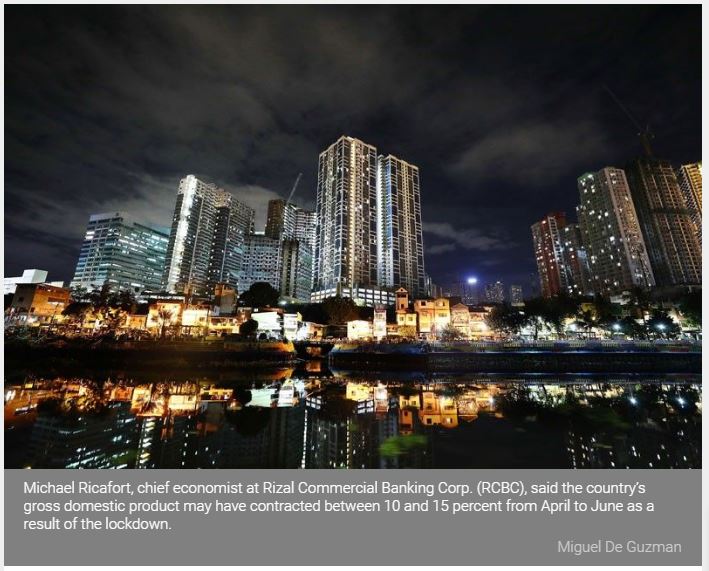Philippines likely slipped into recession in Q2
MANILA, Philippines — The Philippines likely slipped into a recession as the economy is expected to suffer from a double-digit contraction in the second quarter due mainly to the coronavirus lockdown, according to economists of private banks.
Michael Ricafort, chief economist at Rizal Commercial Banking Corp. (RCBC), said the country’s gross domestic product (GDP) may have contracted between 10 and 15 percent from April to June as a result of the lockdown.
“The worst in economic data may have been seen already at the height or peak of the lockdowns from mid-March to mid-May, in terms of sharp reduction in business operations, sales, employment, incomes or livelihood, and other economic activities,” Ricafort said.
The country’s GDP contracted by 0.2 percent in the first quarter, ending 84 straight quarters of positive growth or since the three percent contraction in the fourth quarter of 1998 due to the Asian financial crisis, as Malacañang placed the entire Luzon under enhanced community quarantine in mid- March.
The lockdown was relaxed when the National Capital Region (NCR) was placed under general community quarantine in June to allow the stalled economy to reopen.
“Lockdowns were eased starting the latter part of May and relaxed further well into June, allowing further re-opening of the local and global economies from lockdowns and led to some pick up and improvement in economic data,” Ricafort said.
Ricafort also said that the easing of the lockdown and allowing more businesses or industries to operate and eventually increase capacity in the coming months would lead to a corresponding pickup in economic activities, with more employment, investments, tax revenue collections, and other business opportunities that may entail.
Union Bank of the Philippines chief economist Ruben Carlo Asuncion said the Philippine economy likely fell into a sharp downturn in the second quarter as the economic lockdown was implemented largely in April and May.
Asuncion said the decline in remittances from overseas Filipino workers, the almost zero demand from tourism, the steep decline in employment and business shutdowns caused the decline of economic output in the second quarter.
Moreover, the economist from the Aboitiz-led bank said export performance did record a sharp drop in May, but manufacturing production has also fallen by more than 40 percent.
“But the sharp and continued increase of COVID-19 cases in Metro Manila has somehow dampened the planned reopening from the longest quarantine measure in Asia, if not, in the world,” Asuncion said.
Asuncion warned the government’s fiscal plan may not be enough to cushion a further downturn.
If the P500-billion stimulus plan is approved coupled with the COVID-19 measures implemented by the Bangko Sentral ng Pilipinas (BSP), Asuncion said the GDP contraction of two to 3.4 percent penned by the Development Budget Coordination Committee (DBCC) may be achieved.
If not, Asuncion said the country’s GDP could fall by 6.4 percent this year. A seven percent rebound, however, is expected if and when a vaccine for COVID-19 is discovered and widely administered.
For his part, Security Bank chief economist Robert Dan Roces said the country’s GDP likely contracted by nine percent in the second quarter.
“Growth data is widely expected to have contracted sharply in the second quarter as a consequence of the stringent lockdowns amid enhanced community quarantine measures that took place for the most part of that quarter,” Roces said.
Roces also said contractions may ease starting in the third quarter until the end of the year, resulting in a full-year contraction of four percent.
Meanwhile, the economy likely contracted by 6.1 percent in the second quarter largely because of a downturn in manufacturing activity, according to macroeconomy research firm IHS Markit.
“Second quarter gross domestic product growth for the Philippines is expected to a show a 6.1 percent contraction,” IHS Markit said.
PMI or the Purchasing ManagerPs index data showed a moderation in the manufacturing downturn in the Philippines at the end of the second quarter.s
July manufacturing PMI data for the Philippines will be released this week and will provide insights on whether recovery has gathered pace.
The PMI, which is released a month ahead of official government data, provides a quick overview of the health of the manufacturing sector based on five indicators: new orders, output, job creation, supplier delivery times, and inventories.
PMI readings are now increasingly used as an early indicator of economic performance because of delays in official government data.
Several key economic data will be released by the Philippine Statistics Authority this week.
These include the July inflation rate, June factory output data, June external trade data, second quarter agriculture output, first quarter growth revision, and the actual second quarter economic performance.
The second quarter contraction is widely expected to be deeper than the 0.2 percent decline in the first quarter. — Czeriza Valencia
Source: https://www.philstar.com/business/2020/08/03/2032453/philippines-likely-slipped-recession-q2


 English
English




